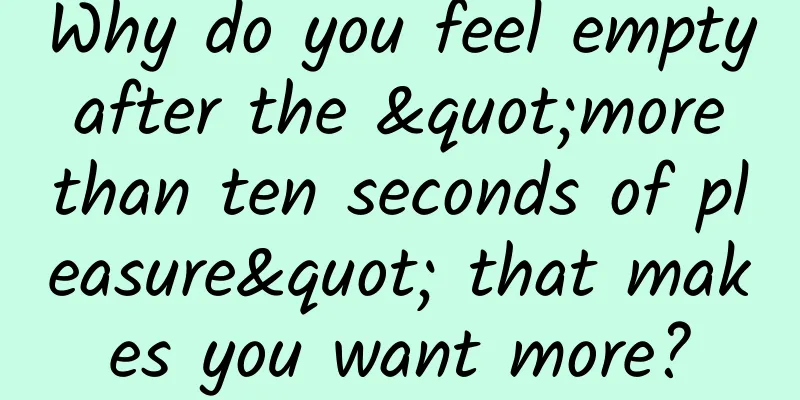What are the clinical manifestations of endometrial polyps?

|
At present, many women are troubled by endometrial polyps, a disease that not only seriously affects the health of women's uterus, but also leads to female infertility. We also know that for women, childbearing is a mission. Once they are unable to bear children, it will be a huge blow to women. Therefore, we must pay attention to this disease. So what are the clinical manifestations of endometrial polyps? Let us take a look together. The main symptoms of endometrial polyps are increased menstrual volume or irregular uterine bleeding; polyps can be seen or touched at the cervical opening and the uterine body is slightly enlarged. Hysteroscopy or segmental diagnostic curettage and sending the removed tissue or polyps for pathological examination can confirm the diagnosis and differentiate it from dysfunctional uterine bleeding, submucosal uterine fibroids and endometrial cancer. Symptom 1: Abdominal pain starts before menstruation or even in the second half of the menstrual cycle, lasts throughout the menstrual period, and gradually disappears after the menstruation is over. As time goes by, dysmenorrhea often becomes progressively worse. Symptom 2: When dysmenorrhea is severe, it is often accompanied by symptoms such as nausea, vomiting, and diarrhea. The root cause of dysmenorrhea is the excessive increase in the content of prostaglandins in the ectopic endometrium and peritoneal fluid, but about 20% of patients may not experience dysmenorrhea. In addition, there may also be sexual pain, intermenstrual bleeding, infertility, etc. Endometriosis grows in the ovaries and can form endometriotic cysts or "chocolate cysts". Sometimes these cysts will rupture and cause acute abdominal pain, which needs to be distinguished from dysmenorrhea. Endometrial polyps can grow anywhere on the uterine wall and at any angle. They can be solitary or multiple. They can be as small as 0.2-0.3 cm or 2-3 cm or larger. They can be oval, triangular or irregular in shape, and most polyps have stalks. Endometrial polyp is a common benign intrauterine lesion in gynecology. Due to the lack of typical and constant symptoms, it is often difficult to diagnose clinically. If clinically patients have symptoms such as menorrhagia, prolonged menstruation, continuous bleeding, infertility, especially when B-ultrasound or hysterography show abnormalities in the uterine cavity, or gynecological examination reveals cervical or endocervical polyps, hysteroscopy should be considered to determine whether there are endometrial polyps. Our hospital's hysteroscopic diagnosis and treatment of endometrial polyps can provide a clear diagnosis, and can locate and take biopsies for pathology. The surgical plan is determined based on the pathological results or the condition of the patient. After excluding endometrial cancer, single, small polyps can be removed under direct hysteroscopy. For patients with multiple lesions or young children who want to have children, a comprehensive curettage can be performed, and a hysteroscope can be inserted after curettage to determine the effectiveness of the curettage. However, the recurrence rate of endometrial polyps treated with curettage is high, so hysteroscopic endometrial resection can be performed for patients who do not want to have children. This can achieve complete treatment while preserving the integrity of the uterus. Intrauterine polyps can be hidden in a woman's uterine cavity without any symptoms. Sometimes they will affect menstruation, such as heavy menstrual flow, prolonged menstrual period, and spotting. Sometimes they will even affect embryo implantation and lead to infertility, etc. Therefore, we should not underestimate these small polyps. Warm reminder: Endometrial polyps may cause infertility. Endometrial polyps fill the uterine cavity, hindering the retention and implantation of sperm and fertilized eggs, and hindering placental implantation and embryo development. Combined infection changes the intrauterine environment, which is not conducive to the survival of sperm and fertilized eggs. Combined with fallopian tube or oophoritis, it can cause obstructive or anovulatory infertility. The main clinical manifestations of endometrial polyps are the ones mentioned above. Female friends must seize the best time to treat the disease and never abuse their bodies. Once you find that your body has the above abnormal symptoms, do not delay any longer and go to a regular gynecological hospital for specific examinations and cooperate with the doctor's treatment. |
<<: What are the clinical symptoms of endometrial polyps?
>>: Treatment of bleeding from endometrial polyps
Recommend
What happens if a woman has a lump in her breast?
The body structure of women is different from tha...
Side effects of mammography
Breast mammography is currently a common method o...
Will leucorrhea cause lower back pain?
Leucorrhea is a common symptom among women. Under...
What to do if the follicles are too large and not discharged
An oversized follicle is an abnormal condition. I...
What should I do if my C1 driver's license is deducted 12 points? Can I drive a motorcycle with a C1 driver's license?
A driver's license is a certificate that allo...
What are the specific and obvious symptoms of excessive liver fire in women?
Many people don’t really understand what liver fi...
How many weeks of pregnancy is it if the period is delayed for 10 days
After getting married or having sex, everyone is ...
How much does a pregnancy blood test cost?
Generally, women will experience relative changes...
Early pregnancy test paper weak positive during ovulation
When testing with a test strip during the ovulati...
How to pair Bluetooth headsets? Can Bluetooth headsets be connected to two mobile phones?
Bluetooth headsets are an increasingly popular el...
Can uterine fibroids turn into cancer?
Uterine fibroids are a common gynecological disea...
95% of suicides can be avoided through psychological intervention or timely rescue
September 10th is the 19th World Suicide Preventi...
How big a teratoma is needed for surgery?
Ovarian teratoma, as the name suggests, is a tumo...
How to reduce acrylamide in food
Recently, the Shenzhen Consumer Council randomly ...
A famous male singer passed away at the age of 37... How to distinguish between melanoma and ordinary moles? 5 criteria to complete self-examination
According to media reports, Zhang Hengyuan, the r...









